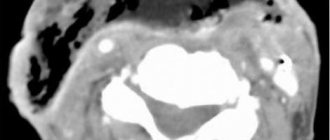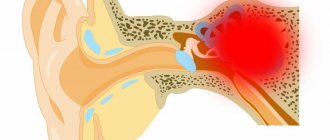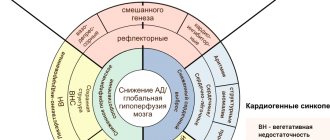Heart symptoms
With cardioneurosis, the main discomfort for patients comes from attacks of pain in the heart. Their intensity varies, as does the duration, which varies from 15 minutes to 2-3 days. An attack occurs mainly after stress. Its frequency is individual in each case. Suspicious people can experience discomfort 5 times a day. Other patients suffer from attacks of heart pain only 1-2 times a year due to nervous exhaustion.
Patients remember the manifested pain in the heart well and begin to worry greatly about their condition. The situation reaches the point of an obsession about imminent death. Cardiologists and therapists have to deal with particularly suspicious patients. Doctors try to explain to the patient that no organic lesions have been identified and recommend contacting a psychotherapist.
It is problematic to draw an overall clinical picture, since patients describe their condition in different ways. We have to focus on the most common cardiac symptoms of cardioneurosis:
- aching and throbbing pain combined with increased sensitivity of the skin on the part of the heart;
- feeling of emptiness in the chest;
- pain throughout the left half of the body with a focus in the heart area;
- pain radiating to the back, head, neck and genitals;
- pressing sensation in the chest;
- stabbing and cutting sensations in the chest, preventing deep breathing.
Pain in the chest is not relieved by Nitroglycerin tablets and other cardiac medications and decreases only after rest. You can distinguish an attack of cardioneurosis from heart disease by the following nuances in the patient’s behavior:
- When describing the symptoms of heart neurosis, the patient tries to embellish it and each time the story changes a little.
- An attack of cardioneurosis causes a person to have obsessive thoughts about imminent death and the “severity” of cardiac pathology. He becomes overly concerned about his health and often experiences panic attacks.
- An attack causes a person to fuss excessively, actively gesticulate, alternately apply cold and heat to the chest, and take all kinds of heart medications.
People who actually suffer from diseases of the cardiovascular system behave with restraint. They can take the medication recommended by the doctor and call an ambulance if necessary. With neurosis, a person is excessively fussy, which reveals his real illness. Calling an ambulance during an attack is often provoked by obsessive thoughts. Visiting doctors must distinguish real cardiac pathology from a panic attack and advise how to treat cardiac neurosis.
about the problem
Cardioneurosis (false heart pain) is paroxysmal painful sensations in the heart area in the absence of organic pathology of the heart itself (i.e., the heart muscle tissue is not affected).
The disease manifests itself in the form of sudden attacks of palpitations, pain or discomfort in the heart area. By their nature, such pain can be constant aching or paroxysmal, dull, sharp, burning, with a feeling of heaviness, squeezing or tingling.
Pain can spread from the heart to the left shoulder blade, to the back, to the neck, to the lower back, to the perineal organs. Sometimes there is a burning sensation under the lower ribs on the left, a “lump in the throat,” and unpleasant sensations in various parts of the body.
In addition to the pain in the heart itself, cardioneurosis is characterized by fading and interruptions in its work, numbness of the skin of the chest, headaches, dizziness, coldness and sweating of the hands and feet. In more severe cases, there is a feeling of lack of air, suffocation, attacks of heat or chills, a feeling of loss of consciousness, accompanied by fear and a panic attack.
The frequency of attacks in cardioneurosis ranges from several per day to 1-2 per year.
The first attack of cardioneurosis usually occurs suddenly after a stressful situation. However, the ground for the emergence of complaints has already been prepared by long-term illnesses, chronic emotional stress and overwork, regular lack of sleep, bad habits and intoxications. Outside of attacks, a person during emotional stress may feel palpitations and sweating of the hands. Characterized by sudden mood swings during the day, fluctuations in blood pressure, weather dependence, decreased performance, and sleep disturbances.
Cardioneurosis develops against the background of a disruption of the nervous system, which causes interruptions in the heart. The causes of malfunction of the nervous system are: impaired cerebral circulation, infections of the nervous system, nervous tension, constant overwork, bad habits, chronic diseases, hormonal changes in the body.
Cardioneurosis can lead to the development of severe heart diseases such as angina, hypertension and others.
General clinical picture
The cardiac symptoms of cardioneurosis worry patients most of all, but other manifestations are also characteristic of the disease. Their intensity varies depending on the individual characteristics of the person. General symptoms of cardiac neurosis during an attack are usually the following:
- a feeling of anxiety that develops into panic;
- obsessive thoughts (obsessive syndrome) about imminent death and the development of fatal pathologies;
- feeling of a lump in the throat;
- lack of oxygen;
- frequent shallow breathing;
- feeling tired even with the slightest overload;
- inability to take a deep breath;
- headache;
- excessive sweating;
- alternating sensations of heat and cold throughout the body;
- loss of consciousness or faintness.
After the attack ends, the person feels a loss of strength and drowsiness. Heavy thoughts appear in your head that prevent you from falling asleep at night.
General symptoms
Anxiety and panic often accompany pain attacks.
In addition to heart pain, patients with cardioneurosis experience a whole range of other clinical manifestations of this disease. Like heart pain, it can vary from attack to attack and is expressed to varying degrees in one patient or another.
Common symptoms of cardioneurosis include:
- feeling of anxiety;
- panic;
- obsessive thoughts about a serious illness;
- painful thoughts after waking up;
- fear of death;
- lump in throat or choking;
- rapid or shallow breathing;
- inability to take a deep breath;
- rapid fatigue even with minor physical or mental stress;
- dizziness and headaches;
- sensations of heat;
- increased sweating;
- constant feeling of cold;
- alternating sensations of heat and cold;
- drowsiness;
- restless behavior during sleep;
- insomnia;
- fainting or fainting.
Such symptoms can reappear at the slightest trouble, negative memories, abuse of coffee or alcoholic beverages, lack of sleep, the appearance of obscure pain, etc. The obsession with the idea of a serious illness often becomes the reason for regular calls to the ambulance team or visits to the doctor. In most cases, ambulance staff successfully recognize and stop an attack of cardioneurosis after taking an ECG and administering sedatives, but sometimes such patients are hospitalized.
Causes
The development of cardioneurosis is influenced not only by external factors, but also by internal ones. A full list of reasons can be seen below:
- hormonal surges associated with illness, adolescence, pregnancy, menopause, taking medications;
- long-term course of pathology without improvement;
- constant feeling of stress;
- insomnia;
- frequent physical and mental overload;
- intoxication due to the effects of chemical compounds on the body;
- bad habits;
- poorly designed diet.
In childhood, the cardiac type of neurosis occurs against a background of stress during school or due to quarrels in the family, parental divorce and other factors that negatively affect the fragile psyche. In adolescence, the reasons remain the same, but the situation is aggravated by hormonal changes.
Cardioneurosis: causes
The immediate cause of the characteristic manifestations of cardioneurosis are disturbances in the body’s regulatory systems (nervous, immune, endocrine, cardiovascular), which are responsible for its response to external influences and maintaining internal stability. These disorders, in turn, arise from a combination of internal conditions and external provoking factors. The first include genetically predetermined constitutional characteristics of a person (types of physiological and mental reactions, including some character traits - mental instability, a tendency to panic, suspiciousness, anxiety, etc.). The second includes physical and mental trauma; intoxication caused by acute and chronic diseases, poisoning, unhealthy lifestyle, etc. All this leads to chronic stress - “fertile soil” for the development of all types of neurotic disorders.
First aid
The manifestation of cardioneurosis is difficult to predict, especially if a person has not previously experienced such discomfort. You can find out how to get rid of an attack of heart neurosis from the information below:
- During an attack, it is better for the patient to find a well-ventilated room to compensate for the lack of oxygen.
If possible, it is advisable to lie down on a sofa or bed. If they are missing, the floor will do.- Take any mild drug with a sedative (calming) effect (Valocardin, alcohol tinctures of motherwort, lemon balm, valerian).
- Take your pulse. If it can be easily felt and does not malfunction, this means that there are no severe functional impairments.
- Calm down and lie down, trying not to think about anything. Excessive fuss, constant measurements of pressure, pulse and calls to relatives and friends will only increase anxiety.
Relief occurs in about 15-20 minutes. To prevent further attacks, it is advisable to consult a therapist. He will send you for an examination and, based on its results, will draw up a list of recommendations. Drug treatment is required only in severe cases. In most cases, you can get by with lifestyle correction and traditional medicine. If the pain in the heart does not go away or the patient is in a pre-fainting state, then it is necessary to call an ambulance.
What is cardiac neurosis, or cardioneurosis?
Cardioneurosis is a psychosomatic disease. According to the international classification - somatoform autonomic dysfunction. This emphasizes that the disease cardioneurosis is equally determined by both disorders of the heart and blood vessels, and mental problems. For the same reason, psychiatrists, answering the question of what cardioneurosis is, often call it “organ neurosis.”
An attack of heart neurosis is comparable to a vicious circle. At first there is anxiety, a pressing feeling in the chest. Anxiety turns into fear, increasingly stronger, which negatively affects the physical state and intensifies symptoms. The attack passes without noticeable functional disorders in the body, which cannot be said about the psychological consequences. The person develops a panicky fear of a repeat attack. To achieve victory over the disease, this vicious circle must be broken.
- Pharyngeal neurosis: can your throat hurt from nerves?
A person susceptible to attacks of cardiac neurosis often does not understand what cardiac neurosis is and mistakes its symptoms for a serious cardiac pathology.
Note! Pain in the heart with cardioneurosis differs from true cardialgia. A person describes cardioneurosis very emotionally, changes the symptoms, and cannot clearly explain the nature and strength of the attacks. It is typical for patients to blame others for their problems. Bustling and excessive gesticulation are also always present.
A patient who has true heart pain gives a brief, clear description of his sensations. His movements are careful not to cause more pain. The patient does not demonstrate excessive emotionality. But, of course, only a detailed examination can finally confirm or refute heart pathology.
Drug treatment
Drugs are prescribed to relieve pain, normalize heart rhythm, relieve shortness of breath and calm the nervous system. The following groups of medications are mainly used:
- It is advisable to use sedative medications for a course lasting at least 1-2 months to obtain a lasting effect. Alcohol tinctures of herbs (motherwort, peppermint, valerian) and medications with a sedative effect (Valocordin, Validol, Persen) are used.
- Antidepressants (Pyrazidol, Amitriptyline, Imizin) suppress depression, improve mood and stimulate the nervous system. Initially, they often cause drowsiness due to the strong sedative effect, but the side effect gradually wears off.
- Tranquilizers (Seduxen, Phenazepam, Nitrazepam) relieve nervous tension and eliminate anxiety and fear. If the patient is more concerned about phobias that arose against the background of an attack of cardioneurosis, then it is better to take Seduxen. Nitrazepam effectively helps with insomnia, and Phenazepam is used to suppress depression.
- Associated headaches can be eliminated with analgesics (Citramon, Spazgan, Drotaverine).
- Vitamin complexes with a high concentration of B vitamins (“Neurovitan”, “Neuromultivit”) are used to improve the condition of the nervous system.
Potassium-containing drugs (Asparkam, Orocomag) are used to stimulate the conductive function of the heart and normalize the transmission of nerve impulses.
Vitamins, potassium-containing preparations and alcohol tinctures with a sedative effect can be taken without any particular concern. For chemical-based analgesics and sedatives, it is necessary to study the contraindications. It is prohibited to take antidepressants and tranquilizers on your own. They have a strong effect on the nervous system, so they are sold by prescription.
The exceptions are children under 18 years of age and women during pregnancy and breastfeeding. For these groups, drug therapy is selected only by the attending physician, who, after the examination, will tell you how to treat cardiac neurosis and advise safe methods. In other cases, you can self-medicate only at your own peril and risk.
Ultrasound of the heart
With organic, cardiac dyspnea, ultrasound reveals disturbances in either the diastolic (relaxation function) or systolic (contractile) function of the heart.
In respiratory neurosis, both functions of the heart are preserved.
▶️️ Cardiac shortness of breath is treated together with the underlying disease. Diuretics in adequate doses, ACE inhibitors, and beta-blockers are prescribed.
▶️ The success of treating respiratory neurosis is 90% a way of life.
The patient is convinced that the symptom is harmless, and distraction therapy is recommended.
Physical activity, good sleep, and a change of environment have an effect.
Medicines include sedative herbs and light daytime tranquilizers.
If the course persists, the patient is recommended to consult a psychotherapist.
Please note that medications must be prescribed by a DOCTOR
Non-drug therapy
Treatment of cardioneurosis is possible without pills. The essence of non-drug treatment is lifestyle correction:
- try not to get into stressful situations;
- maintain a positive attitude;
- work no more than 7-8 hours a day and take 5 minute breaks once every hour and a half;
- devote at least 6-8 hours to sleep;
- do not overwork physically and mentally;
- walk in the fresh air for 1-2 hours every day;
- exercise (moderately), do morning exercises;
- give up bad habits (smoking, drinking alcohol).
Gymnastics for cardioneurosis should be moderate and aimed at strengthening the heart muscle. Running, swimming and aerobic exercise are good options.
The patient will have to change his diet to get rid of heart neurosis. By giving up fast food, sweets, spices and other unhealthy foods in favor of healthy foods, you can significantly improve your overall health. The daily menu should include more vegetables and fruits. It is advisable to eat at least 4-5 times a day, in small portions. The last meal should be 3-4 hours before bedtime.
People who spend most of their time working need to dilute their busy schedule. You should rest at least 2-3 hours a day, doing your favorite hobby, listening to music or going to a massage.
HEALING MIXTURE
Myocardial infarction
I would like to offer a recipe for strengthening the heart muscle and nervous system.
Take 2 tbsp. spoons of nettle leaves, valerian root, coltsfoot leaves, lily of the valley flowers and leaves, mint leaves, walnut leaves, 1.5 tbsp. spoons of yarrow flowers, flowers and leaves of marshmallow, linden blossom, oregano, 1 tbsp. a spoonful of chamomile and 4 tbsp. spoons. crushed rose hips. Mix the herbs thoroughly. 3 tbsp. spoons of the mixture pour 300 ml of boiling water. Leave for 4 hours, strain, squeeze out. Add the juice of one lemon and 1-2 teaspoons of honey.
Divide the resulting product into 3 parts and take warm 20 minutes before meals.
The infusion can be drunk by people who have suffered a myocardial infarction, coronary artery disease, or hypertension. The medicine is useful for patients with increased nervous stress and neuroses.
Psychotherapy
Taking medications alone can stop the manifestations of the disease, but cannot eliminate its cause. To completely cure cardioneurosis, you will have to normalize the functioning of the nervous system with the help of a psychologist or psychotherapist. Communication with a specialist will eliminate the feeling of anxiety, clear your head of obsessive thoughts and strengthen your psyche to effectively resist panic attacks.
Specialists mainly use the following methods of psychotherapy:
- Rational treatment. The doctor helps the patient understand why attacks occur and then teaches him how to effectively deal with them.
- Cognitive behavioral therapy. During the conversation, the psychotherapist talks about the patient’s actions that provoke the development of cardioneurosis and points out his mistakes in order to prevent their recurrence in the future.
- Family sessions. You can come to a conversation with a specialist with close people with whom the patient spends most of his time. Family psychotherapy is most effective for treating couples and children. During the sessions, the doctor will learn about problems and recommend methods to eliminate them.
- Hypnosis is used if the patient is unwilling or unable to share the hidden reasons for his condition. The specialist will put him to sleep and learn about all the problems on a subconscious level.
To achieve noticeable results, it usually takes about 10-15 sessions. It is advisable to combine them with lifestyle correction. The doctor will recommend drug treatment if necessary.
Treatment of cardioneurosis
The main place in the treatment of cardioneurosis, as a somatoform or so-called psychosomatic disorder in the broad sense, is occupied by drug psychotropic therapy: anxiolytic (anti-anxiety) drugs, tranquilizers, low-potency neuroleptics and antipsychotics with a sedative effect, antidepressants, beta-blockers. Pharmacotherapy must be individualized and cannot be prescribed according to a template. It is also necessary to include psychological correction and psychotherapy in the treatment of cardioneurosis. If a person understands and is aware of the possible psychophysiological causes of his condition, he does not give in to panic. Treatment prescribed by a doctor can easily help with this condition. If a vicious circle of anxiety-phobic symptoms and panic attacks has formed, you cannot do without the help of a psychotherapist. The main thing in rehabilitation for such a person is the formation of stress tolerance skills.
Therefore, you should not neglect your health and get away with any symptoms. You need to listen to your body. The body is the temple in which you live. Listen and take care of yourself!
We constantly detect plagiarism on our materials without providing a clickable follow link to them. In this case, without warning, we turn to Google DMCA , which leads to pessimization of the plagiarist. On the contrary, we welcome the popularization of our materials, but with the obligatory active follow link to this page psyhosoma.com/kardionevroz-somatoformnoe-psixosomaticheskoe-rasstrojstvo/ .
Folk remedies
Folk remedies help with the treatment and relief of symptoms of heart neurosis. In most cases, herbal teas with a sedative effect are used. They actually have no contraindications, except for individual intolerance, but during preparation it is important to follow the dosages indicated in the recipe. If you exceed them or underestimate them, the effect will be too strong or completely absent. As a standard, 1-2 tbsp is taken for preparing the decoction. l. main ingredient per 500 ml of water or alcohol. Then the resulting mixture is thoroughly mixed and left to infuse.
The following folk remedies are the most effective for treating and relieving symptoms of heart neurosis:
- A decoction of mint and valerian roots calms the nerves well. You can prepare the medicine by taking 1 herb or both in equal proportions. It is taken instead of tea, 2 times a day.
- The combination of dried apricots, raisins and hawthorn, viburnum and rowan fruits will saturate the body with the microelements necessary for the normal functioning of the heart and nervous system. Prepare like a regular decoction. You can drink it instead of tea 2-3 times a day.
- Drink warm milk at night with the addition of 1 tsp. honey improves sleep and calms the nervous system.
The following fees can be used as a remedy for the treatment of cardioneurosis:
- mint, valerian roots, hop cones, three-leaf watch;
- hawthorn fruits, oregano, motherwort;
- hop cones, yarrow, valerian roots, lemon balm.
After preparing one of the decoctions, it should be taken 3 times a day, 100 ml. Course duration – 1 month. If allergy symptoms occur, treatment of heart neurosis with folk remedies is stopped, and you should consult a doctor as soon as possible.
Melissa will give you health
Melissa
For cardiac neuroses, a collection of lemon balm, valerian, yarrow, and St. John's wort helps.
Herbs are mixed in equal quantities, 2 tbsp. spoons of the collection are brewed with 0.5 liters of boiling water, left for 1 hour, filtered. Add honey to taste and take 0.5 cups 3 times a day before meals for 2-3 months. After each month of treatment there is a 10-day break.
Cardioneurosis with dysfunction of the autonomic nervous system responds well to treatment with a collection of lemon balm, motherwort, peppermint, valerian officinalis, and blood-red hawthorn flowers.
1.5 tbsp. spoons of the collection are poured into 0.5 liters of boiling water, left for 2 hours, filtered and taken 0.5 cups 4 times a day before meals in courses of 2-3 months with breaks per month.
In case of cardioneurosis with increased thyroid function, along with drug treatment, it is recommended to take a collection of equal parts by weight of lemon balm herb, blood-red hawthorn flowers, common thyme, common agrimony, European grasshopper and valerian officinalis. 2 tbsp. spoons of the mixture are poured into 0.5 liters of cold water, boiled for 3 minutes, left for 1 hour, filtered, and honey is added to taste.
Drink 0.5 glasses 4 times a day for 2 months (a month of taking it - a week break - another month of treatment).
A feeling of shortness of breath is perhaps the third most common complaint during an appointment with a cardiologist, after symptoms of increased blood pressure and chest pain.
However, respiratory discomfort does not always indicate a pathology of the heart or lungs.
The fact is that breathing is a function of the body that is easily controlled by a person, which makes it vulnerable to neuroses and anxiety states.
Anxiety and high blood pressure
How to distinguish cardiac shortness of breath from neurotic (or hyperventilation, as it is also called) - more on that below.
CONDITIONS OF APPEARANCE
- Cardiac shortness of breath (if we are talking about chronic diseases) in the early stages occurs only during physical exertion.
- It develops gradually, progresses slowly over years.
- Respiratory discomfort during neurosis occurs at rest, the course is wavy, and physical activity, on the contrary, leads to an improvement in well-being or a reduction in symptoms.
- Respiratory neurosis usually intensifies with an influx of anxious thoughts and unfavorable external conditions.
Forecast
Cardioneurosis is successfully eliminated in the early stages. Residual effects and relapses do not occur with an integrated approach to treatment.
In its advanced state, the disease has a detrimental effect on the patient’s psycho-emotional background. He becomes suspicious, overly irritable and fearful. A constant feeling of anxiety negatively affects all internal processes. Basically, the stool is disrupted, hypertension and angina develop. Treatment will be aimed at reducing nervous excitability and stabilizing the digestive and cardiovascular systems.
Cardioneurosis is a psychosomatic disease. Its development is provoked by frequent stress and overwork. The main problem arises in the diagnostic process. To differentiate cardiac neurosis, the therapist will have to exclude all similar pathological processes. After successful diagnosis, the patient is given recommendations for lifestyle correction. In advanced stages, medication may be prescribed. Psychotherapy and folk recipes are successfully used to complement the course of treatment.
What is cardioneurosis, or Da Costa's syndrome?
Cardioneurosis, “hysterical neurosis of the heart”, “military heart syndrome”, also known as “Friar Da Costa syndrome”, “organ neurosis” or in medicine “somatoform autonomic dysfunction of the cardiovascular system”, is a form of psychosomatic disorder. The first case of cardioneurosis in psychoanalysis was described by S. Freud in 1895. He described a case of a neurotic “heart attack” suffered by a man who, upon learning of his father’s death, began to suffer from fear neurosis.
At the moment, cardionerosis occurs with a frequency of 21-56%. Such conditions, accompanied by cardiophobia (“what if the heart stops”), are diagnosed in 70-80% of people who seek treatment for pain in the heart area. Among people sent for angiography (no or clinically insignificant coronary artery stenosis), this rate is 10-60%. The proportion of people with cardiac neurosis admitted to the emergency department with suspected urgent pathology is 69-88%. In Moscow and St. Petersburg, cardioneurosis occurs in 4.7-19% of patients in the general medical network. In outpatient practice - up to 31.6% and more often develops in women (in 70% of cases).
What are the criteria for cardioneurosis?
Continuous or recurrent symptoms for more than 3 months:
- Unpleasant sensations or pain in the heart area,
- Changes in the strength and rhythm of heart contractions (rapid heartbeat, tachycardia, extrasystole).
- The emergence or intensification of such symptoms in connection with microstresses, acute stressful situations, or during periods of hormonal changes (pregnancy, menopause, etc.).
- The presence of the following signs of autonomic dysfunction:
- Local sweating
- Cold extremities
- Lability of heart rate with a tendency to tachycardia (“tachycardial neurosis of the heart”),
- Blood pressure lability.
- During the examination. Lability and nonspecific changes in the final part of the ventricular complex; positive ECG tests with potassium chloride, B-blockers, hyperventilation and orthostasis; temporary reversion of the T wave during exercise testing.
What is a pseudocardiac complex?
Cardioneurosis is located between “fear neurosis” and “phobias”. Due to the readiness for the diffuse development of fear, this is rather a neurosis of fear, in which neurotic, phobic symptomogenesis is determined by the fixation of fear in a person’s heart. The development of this fear occurs as a result of a somatically displaced conflict between impulses to break and protection from an unbearable situation. As cardioneurosis becomes chronic, a person experiences other neurotic symptoms. For example, irritable bowel.
Cognitive-behavioral circle of cardioneurosis
When understanding cardioneurosis, it is important to take into account the individual cognitive-behavioral vicious circle of a person (Fig. 2)
Rice. 2 Cognitive-behavioral vicious circle of development and maintenance of cardioneurosis
What causes cardioneurosis?
- Events of rupture and loss, which acquire a pathogenetic character in the patient due to the fact that at the same time, their own unconscious impulses and fantasies arise about gaining “independence” and about possible “losses”.
- Death in the patient's immediate environment. Witness to death. These events often act as triggers for cardioneurosis or a relapse of its return, especially if it is death associated with the cardiovascular system. I note that even just reporting such cases on the Internet can lead to another attack.
- Situations of separation, rupture and loneliness. These situations are very ambiguous. The patient desires, on the one hand, a rupture and, on the other hand, fears it. The presence of such ambivalence is provoked externally and internally by already unbearable relationships of dependence.
What are the psychodynamics of cardioneurosis?
Cardioneurosis is provoked by a conflict of rupture in a person with highly ambivalent traits. A person discovers, on the one hand, the ability to self-defense. On the other hand, there is a certain limitation of one’s capabilities, as well as depressing dependence and unfulfilled expectations. A conflict in the form of a break is clearly connected with the situation that provokes it: the death of a loved one, departure, relocation, illness - with everything that threatens loneliness in a person’s mind.
There is also a connection between the occurrence of cardioneurosis in people with a depressive type of response to stress (depressive neurotic structure). With this type of reaction, a person also has a strong ambivalent attitude, and an aggressive desire for death constantly appears in fantasies simultaneously with the expectation of miraculous salvation and/or healing.
There is a tendency towards symbiotic relationships, the presence of depressive-symbiotic fantasies on the topic of merging (convergence), which is caused by external or internal difficulties in breaking close ties with the mother or father. It is difficult to perceive the death of others or even the message about death, which patients experience as if it concerned them, as their own fate.
Fixation and symbiotic relationship with mother
Among people with cardioneurosis, there are many only children in the family, often growing up without a father, younger sons who are very attached to their mother. The situation or phenomenon of an “only child” who had few opportunities to establish relationships outside the family and was forced for a long time to limit contact with one person (a trusted person). This phenomenon plays a causal role in a person’s further lack of independence and difficulties with separation and distance. S. Freud also stated that this is not so much rejection in itself, but general effeminacy, which later makes a person unable to give up love or, at least temporarily, be content with little. This excessive early attachment predisposes to cardionerosis.
According to psychoanalysis, every addiction in a person’s life is at the same time a refusal, because... it provides little preparation for the natural difficulties of life. Attachment or the alternation of habituation and its abrupt interruption has a particularly unfavorable effect.
There is a point of view (according to J. Bowlby) that traumatic experiences of separation from a significant person, suffered in early childhood, are one of the factors predisposing to cardioneurosis. The conflict lies in the situation of separation anticipated by the patient - that separation that he must “desire” and at the same time “fear”. One’s own fantasies and changes in the external environment represent “situations of temptation.” These situations, which are labeled as "loneliness", cause psychosomatic reactions in the patient in the form of hostility, irritation, anger and fear, which are accompanied by a sympathicotonic readiness to react. In this case, a symptomatic-vasal (vascular) attack develops, which leads to the development of cardiophobia.
Personal radical
- Type A demonstrates direct symbiotic dependence.
- Type B does not tolerate humiliating situations in which they experience vulnerability, behaves emphatically, independently, and exhibits demonstrative, pseudo-independent reactions in their actions.
Treatment tactics for cardioneurosis?
When treating cardioneurosis, preference is given to outpatient treatment, using the comprehensive approach we presented in Figure 3.
Rice. 3 Treatment tactics for cardioneurosis
To this day, the “standard” for providing psychological care to patients with cardioneurosis remains conservative - limited, with a large predominance of the medicinal approach. This approach aims to reduce discomfort symptoms, bypassing the causes and supporting mechanisms of this discomfort. In this regard, people with cardioneurosis often experience relapses and do not respond to treatment according to “standards”. Drug therapy does not focus on the presence of hypochondriacal bodily fixations in a person as a misunderstanding and interpretation of one’s own bodily sensations. In this regard, a protocol of cognitive behavioral psychotherapy is used (Fig. 4).
Rice. 4 Protocol for cognitive behavioral psychotherapy for cardioneurosis
The model we propose allows us to identify the individual cognitive model of cardioneurosis in a person—what mechanisms are involved in the formation and maintenance of a discomforting state. To understand what a person’s idea of illness is (“reality map”), we find out the following aspects:
- Subjective causes of discomfort;
- Flow dynamics;
- Current triggering factors that trigger the presence of this discomfort;
- Specifics of security behavior.
With an emphasis on the individual cognitive model of cardiac neurosis, we create a personalized therapeutic plan that includes multimodal treatment strategies. The presented model shows that the pathogenetic mechanism of cardioneurosis is a certain perceptual, cognitive and social (communicative) behavior of the patient. These behaviors contribute to greater somatic distress in the individual. Often, under the influence of fatigue and accumulated tension, certain physiological functional failures occur, which are accompanied by uncomfortable sensations in the body. In patients with cardioneurosis, sensitivity to these sensations is overly expressed, and “scanning one’s own body” and “listening” are launched on “autopilot”. That is, they pay excessive attention to these sensations. This attention, in turn, leads to an excessive degree of awareness, fixation on these physiological sensations. These sensations are attributed excessive importance and danger. At this moment, patients do not notice anything around them - they are completely focused on the sensations in the body and are immersed in their thoughts. They develop certain patterns of attribution (negative labels) to the listed sensations in the body: “illness,” “dangerous,” “will lead to death.” These cognitive distortions in thinking and feeling vulnerable (vulnerable) are a key line of therapy.
Alexey Melekhin
Candidate of Psychology Sci.
Clinical psychologist of the highest qualification category.
Consultant somnologist
Alexey MelekhinClinical aspectsCBTMedicine
Heart pain and other signs of neurosis
A characteristic sign of neurosis is pain in the sternum. An attack can last from 10-15 minutes to several hours, while the person will be restless, overly emotional, and fussy. He often becomes hysterical. This distinguishes cardioneurosis from true angina, in which the patient, on the contrary, tries to lie down and freezes from painful sensations.
People with neurosis describe pain in different ways - heat or cold in the sternum, the heart feels like it is being squeezed in a vice or, conversely, “jumps out”, it aches or stings. It is noteworthy that the description of the nature and intensity of pain during different attacks will differ. The frequency will also be inconsistent. For example, if a person rests more and his emotional state stabilizes, the pain disappears. At other times, they may bother you several times a week.
Seizures always leave an imprint on the patient’s further condition. Thus, it is precisely for patients with cardioneurosis that an obsessive fear of death is characteristic, which easily provokes panic attacks.
Additionally, a person may exhibit the following signs of neurosis:
- Dizziness, sometimes with nausea and faintness.
- Increased sweating.
- Headache.
- Feeling hot or cold.
- Sleep problems - insomnia or, conversely, drowsiness.
- Difficulty breathing - it is difficult for a person to take a deep breath; rapid, shallow breathing is observed.
Heart diagnostics
The main task of diagnosis for cardiac neurosis is to differentiate the disease from pathologies of the cardiovascular system. A cardiologist can make a preliminary diagnosis by collecting an anamnesis - a characteristic description of attacks, the general emotional state of the patient. And yet, in order to exclude organic heart damage, a person needs to undergo the following examinations:
- Auscultation.
- Resting ECG.
- ECG with stress (stress tests).
- EchoCG.
If no pathologies are identified after the examination, the patient is referred to a psychotherapist and subsequently undergoes treatment from this specialist. In addition, it must be taken into account that neurosis can affect the condition of the heart muscle and cause diseases of the cardiovascular system. In this case, the patient should be observed by two specialists - a cardiologist and a neuropsychiatrist.









